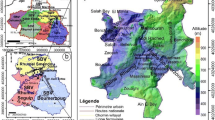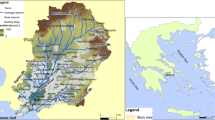Abstract
Metropolitan areas located in arid and semiarid environments are rapidly expanding onto the piedmonts of nearby desert mountains. Hazards to urban development are posed by the complex fluvial systems that characterize these environments, yet no generally accepted methodology exists for evaluating flood hazards on desert piedmonts. An approach to flood hazard assessment is presented that involves the hydrogeomorphic analysis of land surfaces. Five flood hazard zones are identified for an area in central Arizona by analyzing the spatial variation of landforms and their associated fluvial processes. The methodology is applicable to similar environments elsewhere because it is based on the identification of forms and processes common to arid regions. The information provided by the analysis can form the basis for a comprehensive flood hazard management plan.
Similar content being viewed by others
Literature cited
Anderson-Nichols and Company, Inc. 1981. Floodplain management tools for alluvial fans—final report: vol. 1, study findings, 112 pp.; vol. 2, study documentation, 162 pp. Palo Alto, California. Prepared for the Federal Emergency Management Agency, contract EMW-C-0175.
Beaty, C. B. 1964. Origin of alluvial fans, White Mountains, California and Nevada.Annals of the Association of American Geographers 53:516–535.
Beaty, C. B. 1970. Age and estimated rate of accumulation of an alluvial fan, White Mountains, California, U.S.A.American Journal of Science 68:50–77.
Bishop, H. F. 1978. Flood control planning in Albuquerque.Civil Engineering 48:74–76.
Brazel, A. J., and K. Evans. 1984. Major storms and floods in Arizona 1862–1983. Climatological Publications, Precipitation Series 6. Laboratory of Climatology, Arizona State University, Tempe. 63 pp.
Brazel, A. J., and A. Prasad. 1984. Arizona monthly precipitation 1895–1983. Climatological Publications, Precipitations Series 5. Laboratory of Climatology, Arizona State University, Tempe. 6 pp.
Bull, W. B. 1964. Alluvial fans and near-surface subsidence in western Fresno County, California. US Geological Survey Professional Paper 437-A. 70 pp.
Bull, W. B. 1968. Alluvial fans.Journal of Geological Education 16:101–106.
Bull, W. B. 1977. The alluvial fan environment.Progress in Physical Geography 1:222–270.
Cain, J. M., and M. T. Beatty. 1968. The use of soil maps in the delineation of floodplains.Water Resources Research 4:173–182.
Chawner, W. D. 1935. Alluvial-fan flooding, the Montrose, California flood of 1934.Geographical Review 25:225–263.
Christenson, G. E., D. G. Welsch, and T. L. Péwé. 1978. Environmental geology of the McDowell Mountains area, Arizona. Geologic investigation maps: G-1-A (Geology), G-1-B (Landforms) and G-1-G (Geologic Hazards). Arizona Bureau of Geology and Mineral Technology, Tucson. Scale 1:24,000.
Cooke, R. U., D. Brunsden, J. C. Doornkamp, and D. K. C. Jones. 1982. Urban geomorphology in drylands. Oxford University Press, New York. 324 pp.
Cooke, R. U., and A. Warren. 1973. Geomorphology in deserts. University of California Press, Los Angeles. 374 pp.
Dawdy, D. R. 1979. Flood frequency estimates on alluvial fans. American Society of Civil Engineers,Journal of the Hydraulics Division 105:1401–1413.
Denny, C. S. 1967. Fans and pediments.American Journal of Science 265:81–125.
Dunne, T., and L. B. Leopold. 1978. Water in environmental planning. W. H. Freeman, San Francisco. 818 pp.
Federal Emergency Management Agency. 1983. Interagency flood hazard mitigation report: FEMA-691-DR-AZ. In response to October 5, 1983, damage declaration, southern Arizona. Prepared by region 9 Flood Hazard Mitigation Team. 41 pp.
Hadley, R. F. 1967. Pediments and pediment-forming processes.Journal of Geological Education 15:83–89.
Hogg, S. E. 1982. Sheetfloods, sheetwash, sheetflow, or ... ?Earth Science Reviews 18:56–76.
Hooke, R. L. 1967. Processes on arid region alluvial fans.Journal of Geology 75:438–460.
Ives, R. L. 1936. Desert floods in Sonoyta Valley.American Journal of Science 32:349–360.
Jahns, R. H. 1949. Desert floods. Pages 10–14in Engineering and Scientific Monthly. California Institute of Technology, May.
Joly, F. 1965. Hydrology of arid and semiarid regions. Page 25, section 24,in V. T. Chow (ed.), Handbook of applied hydrology. McGraw-Hill, New York.
Lewis, D. D. 1963. Desert floods: a report on the southern Arizona floods of September 1962. Water Resources Report 13. Arizona State Lands Department, Tucson. 30 pp.
Lowdermilk, W. C. 1953. Floods in deserts. Pages 365–377in Desert Research Council, Proc. of the International Symposium on Research Council, Jerusalem, Israel, 7–14 May 1952. Special publication 2.
Lustig, L. K. 1965. Clastic sedimentation in Deep Springs Valley, California. Pages 131–197in US Geological Survey Professional Paper 352-F.
Magura, L. M., and D. E. Wood. 1980. Flood hazard identification and floodplain management on alluvial fans.Water Resources Bulletin 16:56–62.
McGee, W. J. 1897. Sheetflood erosion.Geological Society of America Bulletin 8:87–112.
McGinn, R. A. 1980. Flood frequency estimates on alluvial fans, discussion. American Society of Civil Engineers,Journal of the Hydraulics Division 106:1718–1720.
Melton, M. A. 1965. The geomorphic and paleoclimatic significance of alluvial deposits in southern Arizona.Journal of Geology 73:1–38.
Perkins, B. 1978. Planning the physical form of an arid-region new community.In G. Golany (ed.), Urban planning for arid zones: American experiences and directions. John Wiley and Sons, New York. 245 pp.
Rahn, P. H. 1967. Sheetfloods, streamfloods, and the formation of pediments.Annals of the Association of American Geographers 57:593–604.
Ritter, D. L. 1978. Process geomorphology. William C. Brown, Dubuque, Iowa. 603 pp.
Rodine, J. D., and A. M. Johnson. 1976. The ability of debris, heavily freighted with coarse clastic material, to flow on gentle slopes.Sedimentology 23:213–234.
Schick, A. P. 1971. A desert flood; physical characteristics; effects on man, geomorphic significance, human adaptation; a case study of the southern Arava watershed.Jerusalem Studies in Geography 2:91–155.
Schumm, S. A. 1977. The fluvial system. John Wiley and Sons, New York. 338 pp.
Scott, K. M. 1973. Scour and fill in Tujunga Wash: a fan head valley in urban southern California, 1969. US Geological Survey Professional Paper 732-B. 29 pp.
Sharp, R. P., and L. H. Nobles. 1953. Mudflows of 1941 at Wrightwood, southern California.Geological Society of America Bulletin 64:547–560.
Spearing, D. R. 1974. Alluvial fan deposits. Summary sheets of sedimentary deposits, sheet 1. Geological Society of America. Boulder, Colorado.
Troxell, H. L., and J. Q. Peterson. 1937. Flood in La Canada Valley, California. US Geological Survey Water-Supply Paper 796-C: 53–98.
US Bureau of Census. 1983. Provisional projections of population of states by age and sex: 1980 to 2000. Current Population Reports, Series P-25, no. 937. US Government Printing Office, Washington, DC. 47 pp.
Whitaker, C. R. 1979. The use of the term pediment and related terminology.Zeitschrift für Geomorphologie 23:427–439.
Woolley, R. R. 1946. Cloudburst floods in Utah, 1850–1938. US Geological Survey Water-Supply Paper 994. 128 pp.
Author information
Authors and Affiliations
Rights and permissions
About this article
Cite this article
Rhoads, B.L. Flood hazard assessment for land-use planning near desert mountains. Environmental Management 10, 97–106 (1986). https://doi.org/10.1007/BF01866421
Issue Date:
DOI: https://doi.org/10.1007/BF01866421




